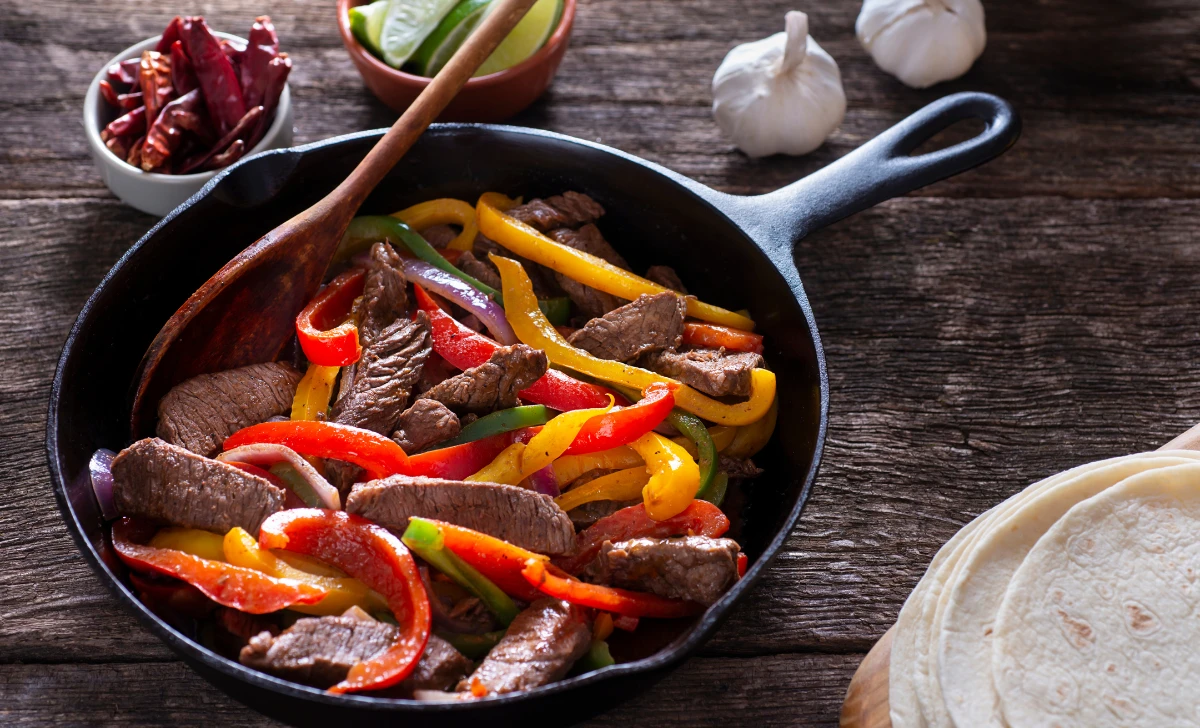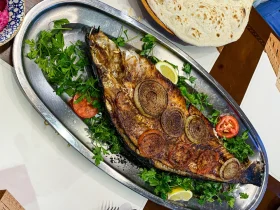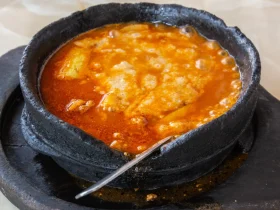Are you ready to tantalize your taste buds with a burst of flavors? Get ready for a culinary adventure as we dive into the delectable world of steak fajitas! This sizzling Tex-Mex dish is not only a treat for your palate but also a breeze to whip up in your kitchen. Whether you’re a seasoned chef or a beginner in the culinary realm, our steak fajitas recipe will guide you through creating a mouthwatering masterpiece that’s sure to impress.
[ez-toc]
History
Step into the realm of culinary history as we trace the origins and evolution of the mouthwatering masterpiece known as steak fajitas. From humble beginnings to becoming a beloved Tex-Mex favorite, the story of steak fajitas is a testament to the fusion of cultures and the art of gastronomy.
Origins in Mexican Ranches
H2: Ranchero Roots
The roots of fajitas trace back to the ranches of northern Mexico in the 1930s. Cattle ranchers, known as vaqueros, would often receive less desirable cuts of meat as their share of the cattle. These tougher cuts, such as skirt steak, were initially overlooked by wealthier consumers.
H2: The Sizzling Solution
Resourcefulness led to innovation. Vaqueros discovered that marinating and grilling these cuts could transform them into flavorful and tender dishes. They would slice the marinated meat into thin strips, a technique that helped break down the tough fibers, and cook them over an open flame, creating a sizzling sensation.
Crossing Borders: Arrival in the United States
H2: A Texan Tale
The migration of fajitas across the border to the United States is where their modern story truly begins. The first recorded instance of fajitas on American soil took place in the 1940s in the Rio Grande Valley of Texas. Mexican workers, known as “taqueros,” introduced their culinary traditions to the local Texans.
H2: Sizzlin’ Sensation
The sizzling sound and aromatic aroma of the cooking meat drew attention, and Texans were quick to adopt this style of cooking. The name “fajitas” itself is derived from the Spanish word “faja,” meaning “belt” or “sash.” This term was used to describe the appearance of the skirt steak, which resembled a belt.
Rise to Popularity
H2: From Border Towns to Mainstream Menus
During the 1960s and 1970s, fajitas gained popularity beyond the border towns. They made their way into restaurants, and their unique presentation—served on a sizzling platter—added an element of theatricality to the dining experience.
H2: Tex-Mex Delight
Fajitas became a staple in Tex-Mex cuisine, which is a fusion of Mexican and Texan flavors. The dish encapsulated the essence of both cultures, blending Mexican marinating techniques with Texan love for grilled meats.
The Modern Twist: Personalization and Creativity
H2: Customizable Creations
As fajitas continued to make their mark, a trend emerged—customization. Restaurants began offering a variety of fillings, from chicken and shrimp to vegetables, catering to diverse dietary preferences.
H2: Culinary Crossroads
The 21st century witnessed a fusion of global flavors with fajitas. Ingredients like Asian-style slaw and Mediterranean-inspired sauces found their way into this Tex-Mex classic, creating a harmonious blend of tastes and textures.
Time
| Step | Time |
|---|---|
| Gather Ingredients | 15 minutes |
| Prepare Marinade | 10 minutes |
| Marinate Steak | 2 hours |
| Slice Peppers and Onions | 15 minutes |
| Sauté Peppers and Onions | 10 minutes |
| Preheat Grill or Skillet | 5 minutes |
| Grill and Sear Steak | 8-10 minutes |
| Rest Steak | 5 minutes |
| Warm Tortillas | 2 minutes |
| Slice Steak | 5 minutes |
| Assemble Fajitas | 5 minutes |
| Prepare Side Dishes | 10 minutes |
| Serve and Enjoy | – |
Note: Times are approximate and may vary based on individual cooking speed and equipment.
Ingredients
| Ingredients | Quantity |
|---|---|
| Flank steak | 1 pound |
| Bell peppers (assorted colors) | 1 each |
| Onion | 1/2 large |
| Olive oil | 3 tablespoons |
| Lime | 1-2 |
| Garlic | 2-3 cloves |
| Smoked paprika | 1 teaspoon |
| Ground cumin | 1 teaspoon |
| Chili powder | 1 teaspoon |
| Salt and pepper | To taste |
| Flour tortillas | 4 |
Directions
Gather the Essentials
- Flank Steak: Take out a pound of flank steak from the refrigerator and let it come to room temperature for even cooking.
- Peppers and Onion: Wash and slice one bell pepper into thin strips, and thinly slice half of a large onion.
Prepare the Marinade
- Marinade Mix: In a bowl, mix 2 tablespoons of olive oil, the juice of one lime, minced garlic, smoked paprika, ground cumin, chili powder, salt, and pepper.
- Marinate the Steak: Place the flank steak in a resealable plastic bag and pour the marinade over it. Seal the bag, ensuring the steak is coated. Refrigerate for at least 2 hours.
Sauté Peppers and Onions
- Heat Olive Oil: In a skillet, heat 1 tablespoon of olive oil over medium-high heat.
- Sauté Veggies: Add the sliced peppers and onions. Sauté for about 5-7 minutes, until they’re tender and slightly caramelized. Set them aside.
Grill and Assembly
H2: Grill the Steak
- Preheat Grill: Preheat your grill to high heat. If using a skillet, preheat it over medium-high heat.
- Remove Excess Marinade: Take the marinated steak out of the bag and let any excess marinade drip off.
H2: Sear and Rest
- Sear the Steak: Place the steak on the grill and sear for 4-5 minutes on each side, or until it reaches your preferred level of doneness.
- Rest and Slice: Remove the steak from the grill and let it rest for about 5 minutes. This allows the juices to redistribute. Then, slice the steak against the grain into thin strips.
H2: Assemble the Fajitas
- Warm Tortillas: Heat the flour tortillas on the grill or in a dry skillet for about 20-30 seconds on each side, until warm.
- Create Fajita Wraps: Lay a few slices of the grilled steak on each tortilla. Top with the sautéed peppers and onions. Drizzle with the juice of half a lime.
Serve and Enjoy
- Sides and Garnishes: Serve the steak fajitas with your favorite sides like guacamole, sour cream, salsa, and grated cheese.
- Dive In: Roll up the tortilla to create a delicious fajita wrap and dig in! Enjoy the explosion of flavors and textures in every bite.
Equipment Required
Nutrition Information
| Nutrition Information | Per Serving |
|---|---|
| Serving Size | 1 fajita wrap |
| Calories | 350 kcal |
| Total Fat | 12g |
| Saturated Fat | 3g |
| Trans Fat | 0g |
| Cholesterol | 40mg |
| Sodium | 480mg |
| Total Carbohydrates | 38g |
| Dietary Fiber | 4g |
| Sugars | 5g |
| Protein | 24g |
| Vitamin D | 0% |
| Calcium | 4% |
| Iron | 20% |
| Potassium | 15% |
Note: Nutritional values are estimated and may vary based on specific ingredients used and portion sizes.
Tips
- Quality Matters: Choose a well-marbled flank steak for the best flavor and tenderness.
- Thin and Even Slices: When slicing the steak, aim for thin, even slices against the grain to ensure a tender bite.
- Marinade Magic: Marinate the steak for at least 2 hours, or even overnight, for maximum flavor infusion.
- Let it Rest: Allowing the steak to rest after grilling ensures juicy and succulent slices.
- Preheat Tortillas: Heating tortillas prevents them from cracking when you fold them and enhances their flavor.
- Customize Heat: Adjust the spice level by increasing or decreasing the amount of chili powder.
- Play with Veggies: Experiment with different bell pepper colors, and add sliced zucchini or mushrooms for extra veggies.
Pros & Cons
| Pros | Cons |
|---|---|
| ✅ Bursting with flavor | ❌ Requires marinating time |
| ✅ Customizable fillings | ❌ Grilling equipment needed |
| ✅ Balanced nutrients | ❌ Potential for overcooking steak |
| ✅ Quick assembly | ❌ May be messy to eat |
| ✅ Ideal for gatherings | ❌ May not be suitable for vegetarians |
Conclusion
As we journeyed through the enticing world of steak fajitas, you’ve witnessed the transformation of simple ingredients into a symphony of flavors and textures that dance on your palate. From the marinade’s magic to the sizzle of the grill, each step is a brushstroke on the canvas of a culinary masterpiece.
Why not embrace the role of a culinary artist and bring this recipe to life in your kitchen? With our easy-to-follow guide, the sizzling sound, the aroma of marinated meat, and the delightful assembly of fajita wraps await your expertise.
Whether you’re gathering friends for a lively evening or treating yourself to a well-deserved feast, steak fajitas are your ticket to a taste adventure. The fusion of succulent steak, sautéed peppers, and zesty lime will transport you to a Tex-Mex haven right in your home.
So, go on, let your creativity sizzle, and dive into a plate of steak fajitas that promises not only a burst of flavors but also a sense of accomplishment. Remember, every chef’s journey is uniquely delightful, and yours is waiting to be savored. Bon appétit!
Facts
- Fact 1: Fajitas’ Flavorful Birthplace 🌮
- Did you know that fajitas were born on Mexican ranches? Vaqueros (cowboys) marinated and grilled tough cuts of meat to transform them into tender delights, giving us the sizzling sensation we adore today!
- Fact 2: Sizzle on the Scene 🍳
- Imagine this: the first fajitas in the United States made their sizzling debut in the 1940s, courtesy of Mexican workers in Texas. The captivating sound and aroma drew crowds, sparking a Tex-Mex revolution.
- Fact 3: A Name with a Belt-tastic Origin 🤠
- Ever wondered about the name “fajitas”? It’s inspired by the Spanish word “faja,” meaning “belt” or “sash.” This term perfectly describes the look of the skirt steak, which resembles a belt—quite a waist-worthy connection!
- Fact 4: Fajitas Fusion Fest 🌍
- The evolution of fajitas isn’t limited by borders. Modern culinary trends have brought together global flavors—think Asian slaw and Mediterranean sauces—to create exciting fajita variations that tantalize taste buds worldwide.
- Fact 5: Versatile Veggies and Beyond 🥦
- While steak is the star, fajitas’ versatility shines bright. Swap meat for shrimp, chicken, or even marinated portobello mushrooms for a veggie delight. The fajita world is your oyster—shuck it!
FAQ’s
Can I use a different type of steak for this recipe?
Absolutely! While flank steak is the traditional choice, you can also use skirt steak, sirloin, or even ribeye for delicious results. Adjust cooking times accordingly.
How can I make the fajitas less spicy?
If you prefer a milder flavor, reduce the amount of chili powder in the marinade. You can also omit or reduce the amount of cayenne pepper if present in your chosen spices.
Can I prepare the steak fajitas in advance?
Certainly! You can marinate the steak and prep the vegetables ahead of time. When ready to serve, grill the steak, warm the tortillas, and assemble the fajitas for a fresh and flavorful meal.
What’s the best way to reheat leftover fajitas?
To maintain the steak’s tenderness, reheat the leftovers in a skillet over medium heat, stirring occasionally until heated through. You can also use a microwave, but be cautious not to overcook.
What sides go well with steak fajitas?
Classic accompaniments include guacamole, sour cream, salsa, and shredded cheese. For a wholesome meal, pair fajitas with rice, beans, or a simple side salad.
How can I make these fajitas gluten-free?
To make the recipe gluten-free, opt for corn tortillas instead of flour tortillas. Check spice blends for any hidden sources of gluten and choose gluten-free soy sauce, if needed.
Can I use a grill pan instead of an outdoor grill?
Absolutely! A grill pan works well for achieving grill marks and a delicious char on the steak. Preheat the grill pan over medium-high heat before cooking.
What’s the difference between flank steak and skirt steak?
Flank steak is leaner and has a mild beefy flavor, while skirt steak has more marbling and a deeper flavor. Both work well for fajitas, so choose based on your preference.
Can I substitute chicken for the steak?
Definitely! Swap the steak for boneless, skinless chicken breasts or thighs. Adjust the cooking time to ensure the chicken is cooked through.
Are steak fajitas suitable for a party or large gathering?
Absolutely! Steak fajitas are perfect for gatherings. You can pre-marinate the meat, chop the vegetables, and warm the tortillas. Allow guests to assemble their own fajitas for a fun and interactive meal.












Leave a Review